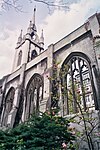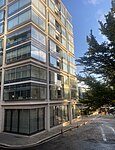Custom House, City of London
1814 in LondonCustom houses in the United KingdomGrade I listed buildings in the City of LondonHistory of the City of LondonPort of London ... and 1 more
Use British English from November 2017

The Custom House, on the north bank of the Thames in the City of London, is a building which was formerly used for the collection of customs duties. A custom house has been present in the area since the 14th century, and a building on its current site has been rebuilt on a number of occasions. Today the Custom House is used by Her Majesty's Revenue and Customs. The address is 20 Lower Thames Street, EC3. Custom House is neighboured on the waterfront by Sugar Quay to the east and Old Billingsgate Market to the west.
Excerpt from the Wikipedia article Custom House, City of London (License: CC BY-SA 3.0, Authors, Images).Custom House, City of London
Lower Thames Street, City of London
Geographical coordinates (GPS) Address External links Nearby Places Show on map
Geographical coordinates (GPS)
| Latitude | Longitude |
|---|---|
| N 51.5087 ° | E -0.08239 ° |
Address
HM Revenue and Customs
Lower Thames Street 20
EC3R 6EN City of London
England, United Kingdom
Open on Google Maps











